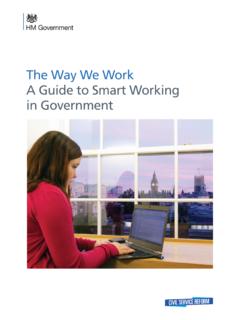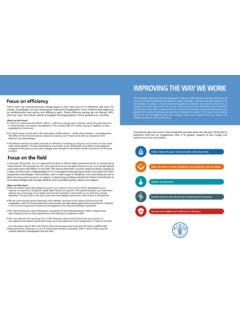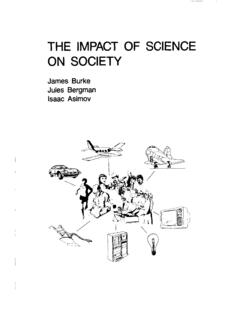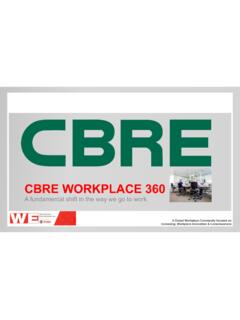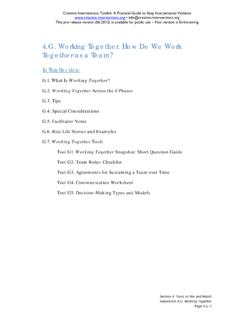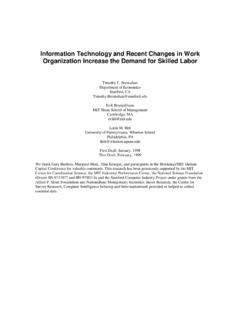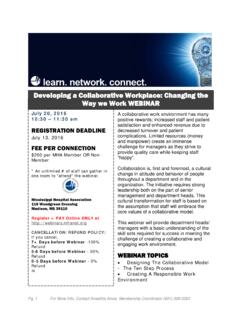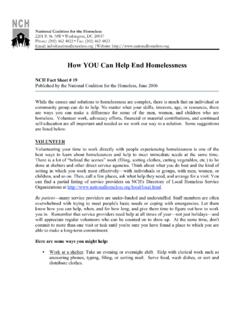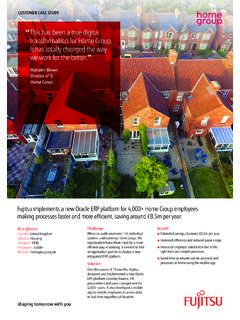Transcription of The Way We Work A Guide to Smart Working in Government
1 the way we work A Guide to Smart Workingin GovernmentThe Way We work A Guide to Smart Working in GovernmentForewordThe Challenge of ReformIt is said that people are an organisation s greatest strongly agree. The dedication and commitment of ourcolleagues is one of the best things about Working inthe Civil all too often people are delivering high qualityservices against a background of outdated IT, poorlydesigned workplaces and inflexible Working can only realise their full potential, and that ofthe organisation they work in, if we empower themwith the right tools and the right environment. Morethan anything we have to free-up the culture of work so that people can just get on with it unhindered. This is why the way we work is so very Civil Service Reform Plan sets out a goal of Creating a decent Working environment for all staff,with modern workplaces enabling flexible Working ,substantially improving IT tools and streamlining securityrequirements to be less burdensome for staff.
2 The WayWe work will help us realise this goal. Working smarter means that we have to challenge allthe assumptions of our traditional ways of Working and bring in new approaches to management andteamwork, with a sharp focus on management by outcomes. We need to develop skills and sharedexpectations about how work is done, and beinnovative in developing more effective and efficientways of the way we work is not a nice-to-have . It is the only way to make sure we provide the servicesour customers expect and demand now and in book is a Guide to Smart Working in centralgovernment. It throws a spotlight on best practice thatis really making a difference to the way people all have our successes but rarely in all people are doing things that are clearly Working ,adopt them as your own. I encourage you to go for it and then share what improved!
3 Martin DonnellyPermanent Secretary, BusinessInnovation and Skills, and Chair of the TW3 Delivery BoardForewordiThe Way We work A Guide to Smart Working in GovernmentContents1 The vision12 Key principles of Smart Working33 People, workstyles and culture change74 New environments for new ways of working155 Technologies for Smart Working276 Smart , sustainable and healthy377 Making the case and implementing change418 Moving forward499 Further resources and information51 ContentsiiiThe Way We work A Guide to Smart Working in GovernmentOur aim for this book is to provide a Guide tothe new ways of Working brought in throughthe Civil Service Reform programme which willenable all parts of the Civil Service to workseamlessly across locations, and at times thatare more advantageous to citizens, employeesand The visionThe way we work is changing but not fastenough.
4 In the current challenging climate, mostcompanies and public sector organisations arelooking closely at what they do and how they do is the time to take steps not only to weatherthe current economic pressures, but also to planfor the longer term. Working smarter should be atthe heart of transforming and streamlining goal is at the heart of the Civil Service Reform we are setting out the vision that by 2015 the CivilService will be more efficient and a better place to work ,where people: Focus on outcomes not process Are empowered by technology work flexibly and cost-effectively Collaborate more effectively with other teams in their own department and other departments Maximise productivity and innovation while reducing environmental aim to ensure that, by end 2015, we will bewell on the way to a Civil Service in which.
5 Well-designed workplaces support how people workbest, with location options such as shared hubs,hosted space, HQs and home work is being done in a variety of appropriatelydesigned shared settings within those workplaces, no longer tethered to a desk IT is usable, convenient and works just as well in andaway from the office; and is comparable to thetechnology people use at home Connectivity to colleagues and to data can beprovided from virtually anywhere Security and access arrangements make it easy andsafe to work in a variety of settings Leaders embrace and exploit the flexibility,productivity and effectiveness offered by the changesto our in the 21st century is about what you do, notwhere you do it. Strategic use of new technologiesenables much of the work we do to be carried out frommany other locations as well as aim for this book is to provide a Guide to the newways of Working brought in through the Civil ServiceReform programme which will enable all parts of theCivil Service to work seamlessly across locations, and at times that are more advantageous to citizens,employees and taxpayers.
6 We call this Smart WorkingThe Way We work (TW3) is the Cabinet Office led cross-departmental programme designed to help realise theCivil Service Reform Plan s aim of Creating a decentworking environment for all staff, with modernworkplaces enabling flexible Working , substantiallyimproving IT tools and streamlining securityrequirements to be less burdensome for staff .Transforming the way we work is not a nice-to-have . It is the only way to make sure we providethe services our customers expect and demand now and in the vision1 Cabinet OfficeThe Cabinet Office itself has ambitious plans fortransformation linked to IT, workplace and culturalreforms and Richard Heaton, Permanent Secretaryfor the Cabinet Office leading this programme says: I am determined to create in the Cabinet Officethe best possible Working environment, withtechnology that meets people s needs.
7 We want tobe able to work more smartly and more flexibly,better able to collaborate across all our teams andto be more creative, innovative and productive. Inthe near future staff will see more choice in theworkplaces they can use and the IT they are offered,whether they re in the office or on the move. TheirIT will be more like the range of devices andsoftware we are all used to outside work . Likeothers we re transforming the way we work and I mpretty sure that when we get this right CabinetOffice will be up there with the best. 2 The Way We WorkWe want to be ableto work more smartlyand more flexiblySmart Working is about taking a comprehensiveand strategic approach to modernising workingpractices across is based on the following principles: work takes place at the most effective locations andat the most effective times, respecting the needs ofthe task, the customer, the individual and the team Simplified collaboration and connectivity virtuallyeverywhere means sharing information and workingwith others regardless of location Space is allocated to activities, not individuals and noton the basis of seniority A Flexibility First approach where flexibility is thenorm rather than the exception.
8 Everyone is assumedto be capable of Smart Working without assumptionsbeing made about people or roles A shared and agreed approach to Smart Workingbalances the freedom to choose with theresponsibility to meet business needs The processes people are asked to work with arecontinuously challenged to make sure they are fit for purpose Managing performance focuses on results andoutcomes rather than presenceThe outcomes of adopting Smart Working will be: Greater productivity and services delivered moreeffectively The costs and environmental impacts of workreduced as space is shared and used more intensively People having more choice about when where andhow they work , supported and connected byeffective and appropriate use of technology People have the opportunity to lead more balancedand healthier will this mean in practice?
9 For departments, this means a new approach tothinking about the way people work in terms of SmartWorking Working provides a strategic and business-focused framework for adopting Smart , agile Working as the norm. This means taking a proactive rather than a reactive approach to flexibility, by seeking out thebenefits rather than waiting for individual employeerequests. Limitations on flexibility need to be based on clear operational by results rather than presence which is best practice in any case will become furtherembedded as a core management competence. Assessing the total costs of how we work should informdecisions about work styles. This includes both thefinancial costs and the environmental costs ( inrelation to use of buildings, resources, and travel). In essence, the footprint of work is a result of the greater flexibility and agility,departments will become more adaptable to example, Working in project teams acrossdepartments, changes to organisational structure andchanges to headcount will become much easier tomanage and involve few of the physical changes toworkplaces that are currently continuity will be enhanced by the ability towork in an all-electronic environment and from a muchwider range of locations.
10 In effect, the office is principles of Smart Working32 Key principles of Smart WorkingFor individuals, this means being empowered tochoose the best times and places to work , varying startand finish times and choosing work settings that suitthe nature of the task and personal preferences so thatthe job can be done well and quickly. Managers focuson the output and employees choose how it a result, trust-based relationships become central forboth employees and managers as people take greaterownership of their work greater autonomy will increase the opportunity tolead more balanced and healthy lives. Smart workingpatterns also underpin and add new dimensions todiversity and summary there are positive impacts from SmartWorking on the Triple Bottom Line benefits for publicservice, for people, and for the Way We WorkAn end to wasteful Working practicesWasteful practices are built into traditional ways of Working : The average UK worker commutes for justunder an hour per day equivalent to 4years over a Working life The average full-time employee is absent days per year, in the public sector There are some 10 million office workers inthe UK occupying 110 million m2of.
